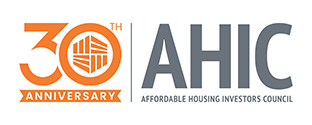
General Asset Management Resources
Details best practices for asset management at both the property and fund-level management. At the property level, it details monitoring processes for construction, lease-up and ongoing portfolio oversight during pre- and post-stabilization phases. Includes specific items to review, reporting requirements and investor considerations that go beyond standard practices. At the fund level, it provides a detailed list of item to confirm.
This document supplements AHIC’s best practices, looking at them through the lens of fairness and justice and identifies questions investors and syndicators may want to ask their sponsor partners about how their properties support and empower residents and meet their needs. The guide covers three main areas: initial leasing practices, human services provision, and building operations. It includes specific questions and considerations for each area, focusing on inclusive communities, resident support and tenant satisfaction.
Risk Rating Guidelines
Most syndicators and investors use AHIC’s Risk Rating guidelines to evaluate and monitor the performance and risk level of Low-Income Housing Tax Credit properties. These documents outline a standardized approach to assessing risk across different phases of a property's lifecycle. Investors use them to consistently evaluate their investments, identify potential issues early, and determine when increased oversight or intervention may be necessary.
- Risk Rating Guidelines Instructions: Provides an overview of the rating system, explaining the five risk ratings (A to F) and when a property should be considered for the Watch List.
- Development Phase Risk Rating Grid: Used to assess properties during construction and initial lease-up. It covers areas such as construction/lease-up progress, financial status, construction and permanent loan status, program compliance, and the status of key stakeholders like the general contractor and developer.
- Stabilized Phase Risk Rating Grid: Used for properties that have completed initial lease-up and are in ongoing operations. It evaluates factors such as debt coverage ratio, economic occupancy, reserves, physical condition, program compliance and financial reporting.
Dispositions and Exits
Together, these documents provide a comprehensive toolkit for LIHTC investors to evaluate, plan, and execute disposition strategies for their investments.
- Dispositions Checklist
High-level guide for a typical disposition exit strategy. Identifies the key items to be collected and analyzed. Can be use with the Internal Valuation Template spreadsheet. - AHIC Dispositions Discussion Paper
Expands on the concepts introduced in the checklist, providing more detailed explanations and considerations. It covers motivations for exits, exit options, valuation analysis, early exits and negotiation points. - Income Valuation Template
Spreadsheet template is used to project the property's income and value over time, which is a crucial part of the valuation analysis discussed in the Dispositions Discussion Paper.
AHIC Standardized Reporting System
Together, these documents create a standardized system for reporting on LIHTC investments to help investors efficiently analyze large portfolios of LIHTC investments. Designed to facilitate consistent communication between syndicators and investors.
- AHIC Property Database Reporting Format
Detailed instructions for syndicators on how to populate the property database. Defines each field that should be reported, including information about the fund, property characteristics, financial data and performance metrics. - AHIC Property Reporting Template
Template used to collect and organize basic information about each property in a fund. Provides a foundation for ongoing reporting. - AHIC Quarterly Reporting Format
Template for reporting quarterly data on individual properties within a fund. It includes information such as occupancy rates, income, expenses, debt coverage ratios, and risk ratings. This format allows for consistent tracking of property performance over time.
Multi-Investor Fund Resources
Together, these documents can be used to provide a comprehensive view of a fund's expected benefits and performance.
- Multi-Investor Fund Benefits Schedule
Template to provide investors with a clear, standardized view of the expected financial performance of a fund over time. Designed to be easily uploaded into investors’ database. - Multi-Investor Fund Review Template
Annual review template investors can use to assess the current state of the fund, identify any potential issues and track performance against projections. Allows investors to see how well the fund is meeting the expectations set out in the Benefits Schedule. - AHIC Quarterly Reporting Format
Template for reporting quarterly data on individual properties within a fund. It includes information such as occupancy rates, income, expenses, debt coverage ratios, and risk ratings. This format allows for consistent tracking of property performance over time.
